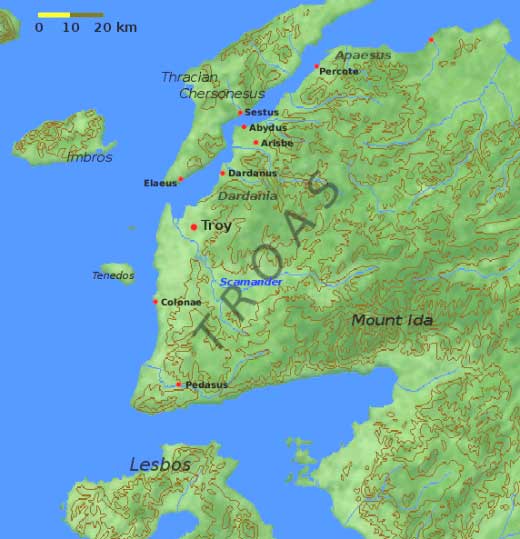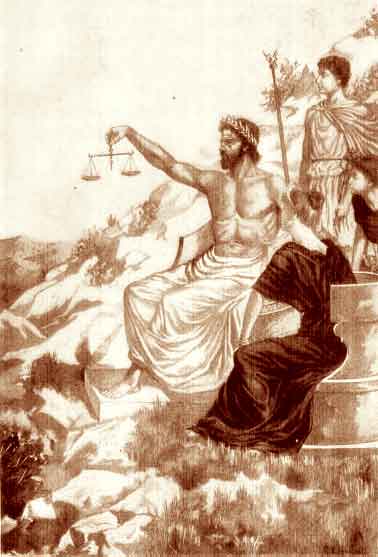.
Two sacred mountains are called Mount Ida in Greek mythology, equally named "Mount of the Goddess." Both sites associated with the Mother Goddess in the deepest layers of pre-Greek myth, are the mountains associated with the Goddess, De (as in the "goddess-mother," De + meter), in an older form Da, "a female deity whose succor and assistance were evoked in archaic formulas by use of this syllable" (Karl Kerenyi, Eleusis: Archetypal Image of Mother and Daughter p.28).

Mount Ida, Phrygia is a mountain, altitude 1,774 m, 39°42′ N 26°51′ E, in the Troad, the environs of ancient Troy, now in Balıkesir Province, northwest Turkey. In modern Turkish it is still named Kaz Dağı (pronounced "Kaz DA-u"). However, a connection with the goddess' syllable seems to be a coincidence, dağ is the element that translates as "mountain"; all other mountains and mountain ranges in Turkey have a name involving the word "dağ".
Mount Ida, Crete, is the island's highest summit, sacred to the Goddess Rhea, and in which lies the cave in which Zeus was reared. Mount Ida in Phrygia is sacred to another aspect of the Great Goddess, as Cybele, the Mother Goddess who is often called Mater Idae ('The Idean Mother").
Phrygian Ida is the scene of several mythic events that affected the early history of Troy. At its summit, the Olympian gods gathered to watch the progress of the epic fight. But the mountain was the sacred place of the Goddess, and Hera's powers were so magnified on Mount Ida, that she was able to distract Zeus with her seductions, just long enough to permit the climactic taking of Troy.
At an earlier time, on Mount Ida, Ganymede, the son of Tros or perhaps of Laomedon, both kings of Troy, was desired by Zeus, who descended in the form of an eagle and swept up Ganymede, to be cupbearer to the Olympian gods. Anchises, father of Aeneas, also of the Trojan royal house, was tending sheep on Mount Ida when he was seduced by Aphrodite.
On the sacred mountain, the nymphs who were the daughter-spirits of the river Cebrenus, had their haunt, and one, Oenone, who had the chthonic gifts of prophetic vision and the curative powers of herb magic, wed Paris, living as a shepherd on Mount Ida. Unbeknownst to all, even to himself, Paris was the son of Priam, king of Troy. He was there on Mount Ida, experiencing the rustic education in exile of many heroes of Greek mythology, for his disastrous future effect on Troy was foretold at his birth, and Priam had him exposed on the sacred slopes. When the good shepherd who was entrusted with the baby returned to bury the exposed child, he discovered that he had been suckled by a she-bear (a totem animal of the archaic goddess Artemis) and took the child home to be foster-nursed by his wife.

Zeus on Mount Ida
When Eris ("discord") cast the Apple of Discord, inscribed "for the fairest", into the wedding festivities of Peleus with Thetis, three great goddesses repaired to Mount Ida to be appraised. By a sacred spring on the mountainside, in "the Judgment of Paris", the grown youth Paris awarded it to Aphrodite, who offered Helen for a bribe, earning the perpetual enmity of the discredited goddesses Hera and Athena to the Trojan cause (Apollodorus, 3:12.5).
During the Trojan War, in an episode recorded in Apollodorus' Epitome (though not in Homer), Achilles with some of the Achaean chiefs laid waste the countryside, and made his way to Ida to rustle the cattle of Aeneas. But Aeneas fled, and Achilles killed the cowherds and Nestor, son of Priam, and drove away the sacred kine (Epitome 3.32).
After the Trojan War, the only surviving son of Priam, Helenus, retired to Mount Ida, where he was surprised and became the captive of Pyrrhus of Epirus.
The oldest collection of Sibylline utterances, the Sibylline books, appears to have been made about the time of Cyrus at Gergis on Mount Ida; it was attributed to the Hellespontine Sibyl and was preserved in the temple of Apollo at Gergis. From Gergis the collection passed to Erythrae, where it became famous as the oracles of the Erythraean Sibyl. It seems to have been this very collection, or so it would appear, which found its way to Cumae (see the Cumaean Sibyl) and from Cumae to Rome.
In historical times, Xerxes I' march took him past Mount Ida (Herodotus VII:42).
In modern times a very modest 2.4 km² of Mount Ida are protected by Kaz Dağı National Park. The summit (1,774 m) is windswept and bare with a relatively low tree-line due to exposure, but the slopes of this mountain, at the edge of mild Mediterranean and colder central Anatolian climate zones, hold a wealth of endemic flora, marooned here after the Ice Age. The climate at lower altitudes has become increasingly hot and dry in the deforested landscape. The forests on the upper slopes consist mainly of Turkish Fir (Abies nordmanniana subsp. equi-trojani; considered by some botanists to be a distinct species Abies equi-trojani). It has been fancifully suggested that the wood used to make the Trojan Horse was cut from these firs, but evidence for this is lacking.
Reference
Martyn Rix, "Wild About Ida: the glorious flora of Kaz Dagi and the Vale of Troy", Cornucopia 26, 2002.
See also : Greek Mythology. Paintings, Drawings
| Ancient Greece
Science, Technology , Medicine , Warfare, , Biographies , Life , Cities/Places/Maps , Arts , Literature , Philosophy ,Olympics, Mythology , History , Images Medieval Greece / Byzantine Empire Science, Technology, Arts, , Warfare , Literature, Biographies, Icons, History Modern Greece Cities, Islands, Regions, Fauna/Flora ,Biographies , History , Warfare, Science/Technology, Literature, Music , Arts , Film/Actors , Sport , Fashion --- |
Retrieved from "http://en.wikipedia.org"
All text is available under the terms of the GNU Free Documentation License

